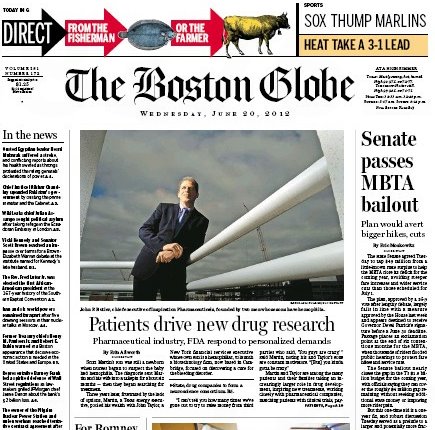 Today’s edition of the Boston Globe features a story about patients’ and patient advocates’ growing impact on drug development as pharmaceutical companies and the FDA respond to demands.
Today’s edition of the Boston Globe features a story about patients’ and patient advocates’ growing impact on drug development as pharmaceutical companies and the FDA respond to demands.
Every paragraph spoke to me. Every reference contained some connection to our own battle with Batten disease. Every word said, this is your story.
A Texas energy executive and a New York financial services executive, both fathers of sons with hemophilia, launched a biotechnology firm focused on a cure for the bleeding disorder because they grew frustrated with the lack of options for their children.
In 2008, 100 yards from my parents’ house, near the end of an hour-long walk fueled by passion for a treatment we could reach out and touch in our dreams but couldn’t fathom in real life, my mom and I made the decision to turn our steering committee with a couple of successful fundraisers, a website, a blog and a small group of dedicated volunteers into the non-profit organization known today as Taylor’s Tale, because we wanted more for children like my little sister.
The Michael J. Fox Foundation for Parkinson’s Research – mentioned a few paragraphs later in the Globe article – served as inspiration at a recent meeting of the board of directors of Taylor’s Tale – still fighting for kids like Taylor in 2012.
In the mid-1990s, Pat Furlong lost her two sons to Duchenne muscular dystrophy. Not long after their diagnosis, she borrowed $100,000 to finance research, posed as a doctor to get face time with Duchenne muscular dystrophy experts and pleaded her case with drug company execs.
Pat Furlong and my mom, Sharon, have a lot in common. They share the same vision. They have the same fearlessness. The same bulldog mentality. In the past several years, my mom has turned to Furlong more than once for advice.
One of the drug companies mentioned in the article, Genzyme, developed a drug ignited by a father who wanted desperately to save his children from Pompe disease – and would stop at nothing to succeed. The father is John Crowley; his story is chronicled by former Globe writer Geeta Anand in the book “The Cure” and, later, the movie “Extraordinary Measures.” At the first meeting of the steering committee that eventually became Taylor’s Tale, my mom gave a copy of “The Cure” to each of the women seated around the room. She gave us two assignments that day: to read the book, and to fight with her, no matter how tough the road might seem; because she believed, she hoped we could believe, too.
I posted a link to another interesting article – this from the Chicago Tribune – on our Facebook page last month. This story focused on parents of children with giant axonal neuropathy (GAN) who hired researchers to develop a treatment. Like Batten disease, GAN is a neurodegenerative disease – though it is far more rare (only 25-30 known cases worldwide, compared with at least 500 known cases of Batten disease in the United States alone). And yet these parents succeeded in raising enough money to put researchers on track for human clinical trial in the near future.
The Tribune article contained a quote from one of the GAN parents that has stayed with me since the moment I read it. In the six years since Taylor’s diagnosis, I’ve never heard anyone describe the existence of the close family member of someone with a rare disease so well:
“After Ethan was diagnosed, people would say to us, ‘Don’t worry, they’ll find a cure,'” Tkalec said. “And I’d say, ‘You don’t understand … there is no ‘they.’ We are the ‘they.'”
She’s right – we are the “they.” For as grateful as I am for the support we’ve received over the years – from building our non-profit organization to supporting it to offering friendship and, on rough days, a shoulder to cry on – I know that ultimately, this fight is ours to fight; that if we don’t fight, no one will. That the minute we stop fighting – the minute we stop believing – that’s when the mountain will become insurmountable.
